Page 1 of 492
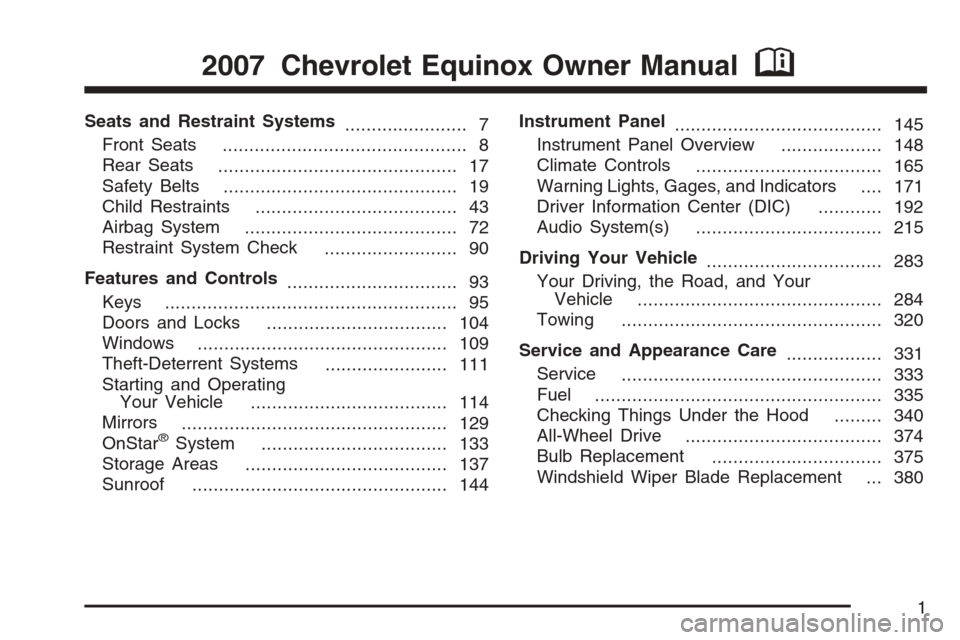
Seats and Restraint Systems
....................... 7
Front Seats
.............................................. 8
Rear Seats
............................................. 17
Safety Belts
............................................ 19
Child Restraints
...................................... 43
Airbag System
........................................ 72
Restraint System Check
......................... 90
Features and Controls
................................ 93
Keys
....................................................... 95
Doors and Locks
.................................. 104
Windows
............................................... 109
Theft-Deterrent Systems
....................... 111
Starting and Operating
Your Vehicle
..................................... 114
Mirrors
.................................................. 129
OnStar
®System
................................... 133
Storage Areas
...................................... 137
Sunroof
................................................ 144Instrument Panel
....................................... 145
Instrument Panel Overview
................... 148
Climate Controls
................................... 165
Warning Lights, Gages, and Indicators
.... 171
Driver Information Center (DIC)
............ 192
Audio System(s)
................................... 215
Driving Your Vehicle
................................. 283
Your Driving, the Road, and Your
Vehicle
.............................................. 284
Towing
................................................. 320
Service and Appearance Care
.................. 331
Service
................................................. 333
Fuel
...................................................... 335
Checking Things Under the Hood
......... 340
All-Wheel Drive
..................................... 374
Bulb Replacement
................................ 375
Windshield Wiper Blade Replacement
... 380
2007 Chevrolet Equinox Owner ManualM
1
Page 14 of 492
Pull the head restraint up
to raise it. To lower the
head restraint, press the
button, located on the
top of the seatback, and
push the restraint down.Passenger Folding Seatback
The front passenger’s seatback may fold �at.
{CAUTION:
If you fold the seatback forward to carry
longer objects, such as skis, be sure any
such cargo is not near an airbag. In a
crash, an in�ating airbag might force that
object toward a person. This could cause
severe injury or even death. Secure objects
away from the area in which an airbag
would in�ate. For more information, see
Where Are the Airbags? on page 75and
Loading Your Vehicle on page 315.
14
Page 17 of 492
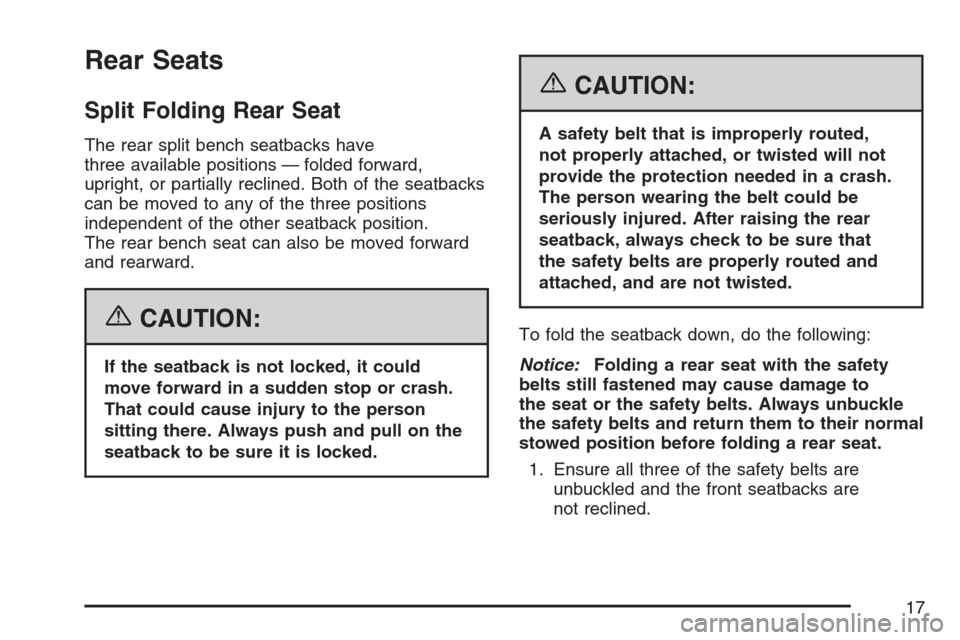
Rear Seats
Split Folding Rear Seat
The rear split bench seatbacks have
three available positions — folded forward,
upright, or partially reclined. Both of the seatbacks
can be moved to any of the three positions
independent of the other seatback position.
The rear bench seat can also be moved forward
and rearward.
{CAUTION:
If the seatback is not locked, it could
move forward in a sudden stop or crash.
That could cause injury to the person
sitting there. Always push and pull on the
seatback to be sure it is locked.
{CAUTION:
A safety belt that is improperly routed,
not properly attached, or twisted will not
provide the protection needed in a crash.
The person wearing the belt could be
seriously injured. After raising the rear
seatback, always check to be sure that
the safety belts are properly routed and
attached, and are not twisted.
To fold the seatback down, do the following:
Notice:Folding a rear seat with the safety
belts still fastened may cause damage to
the seat or the safety belts. Always unbuckle
the safety belts and return them to their normal
stowed position before folding a rear seat.
1. Ensure all three of the safety belts are
unbuckled and the front seatbacks are
not reclined.
17
Page 44 of 492
{CAUTION:
Never do this.
Here two children are wearing the same
belt. The belt can not properly spread the
impact forces. In a crash, the two children
can be crushed together and seriously
injured. A belt must be used by only
one person at a time.
Q:What if a child is wearing a lap-shoulder
belt, but the child is so small that the
shoulder belt is very close to the child’s
face or neck?
A:If the child is sitting in a seat next to a window,
move the child toward the center of the vehicle.
Also seeRear Safety Belt Comfort Guides on
page 39. If the child is sitting in the center rear
seat passenger position, move the child toward
the safety belt buckle. In either case, be sure
that the shoulder belt still is on the child’s
shoulder, so that in a crash the child’s upper
body would have the restraint that belts
provide.
44
Page 49 of 492
{CAUTION:
The body structure of a young child is
quite unlike that of an adult or older child,
for whom the safety belts are designed. A
young child’s hip bones are still so small
that the vehicle’s regular safety belt may
not remain low on the hip bones, as it
should. Instead, it may settle up around
the child’s abdomen. In a crash, the belt
would apply force on a body area that is
unprotected by any bony structure. This
alone could cause serious or fatal injuries.
Young children always should be secured
in appropriate child restraints.
Child Restraint Systems
An infant car bed (A), a special bed made for use
in a motor vehicle, is an infant restraint system
designed to restrain or position a child on a
continuous �at surface. Make sure that the infant’s
head rests toward the center of the vehicle.
49
Page 61 of 492
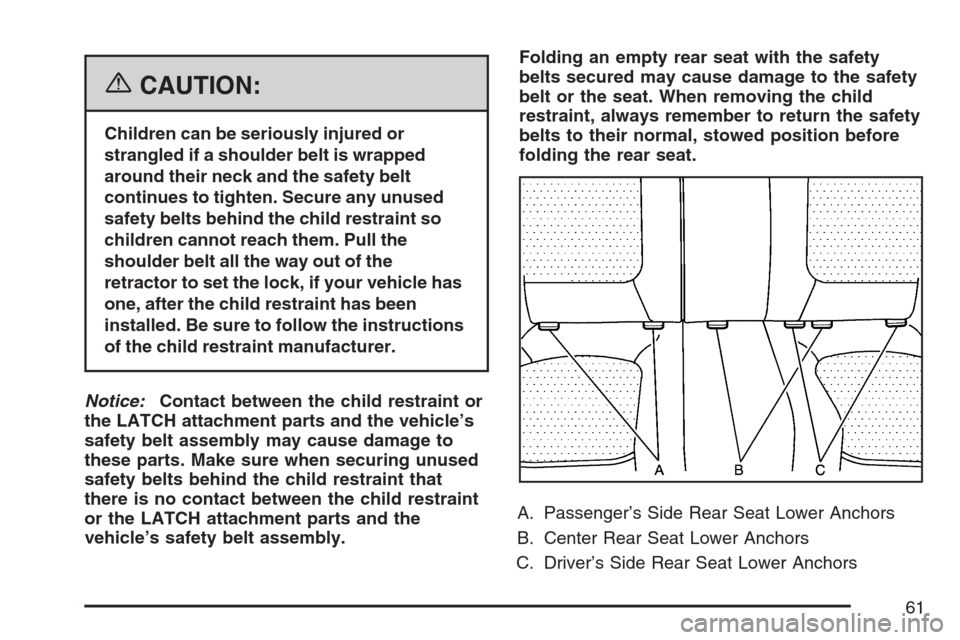
{CAUTION:
Children can be seriously injured or
strangled if a shoulder belt is wrapped
around their neck and the safety belt
continues to tighten. Secure any unused
safety belts behind the child restraint so
children cannot reach them. Pull the
shoulder belt all the way out of the
retractor to set the lock, if your vehicle has
one, after the child restraint has been
installed. Be sure to follow the instructions
of the child restraint manufacturer.
Notice:Contact between the child restraint or
the LATCH attachment parts and the vehicle’s
safety belt assembly may cause damage to
these parts. Make sure when securing unused
safety belts behind the child restraint that
there is no contact between the child restraint
or the LATCH attachment parts and the
vehicle’s safety belt assembly.Folding an empty rear seat with the safety
belts secured may cause damage to the safety
belt or the seat. When removing the child
restraint, always remember to return the safety
belts to their normal, stowed position before
folding the rear seat.
A. Passenger’s Side Rear Seat Lower Anchors
B. Center Rear Seat Lower Anchors
C. Driver’s Side Rear Seat Lower Anchors
61
Page 72 of 492
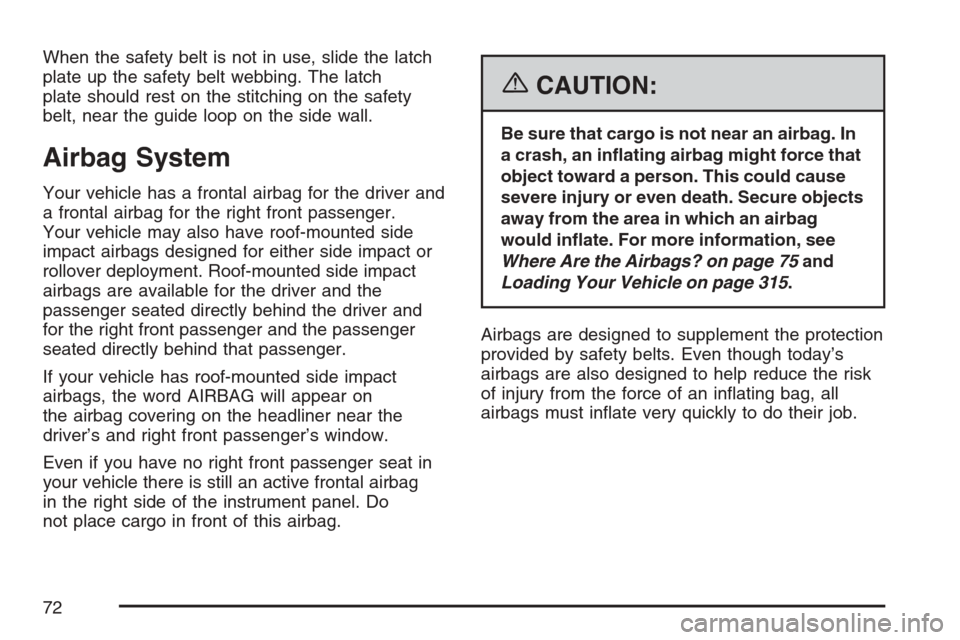
When the safety belt is not in use, slide the latch
plate up the safety belt webbing. The latch
plate should rest on the stitching on the safety
belt, near the guide loop on the side wall.
Airbag System
Your vehicle has a frontal airbag for the driver and
a frontal airbag for the right front passenger.
Your vehicle may also have roof-mounted side
impact airbags designed for either side impact or
rollover deployment. Roof-mounted side impact
airbags are available for the driver and the
passenger seated directly behind the driver and
for the right front passenger and the passenger
seated directly behind that passenger.
If your vehicle has roof-mounted side impact
airbags, the word AIRBAG will appear on
the airbag covering on the headliner near the
driver’s and right front passenger’s window.
Even if you have no right front passenger seat in
your vehicle there is still an active frontal airbag
in the right side of the instrument panel. Do
not place cargo in front of this airbag.
{CAUTION:
Be sure that cargo is not near an airbag. In
a crash, an in�ating airbag might force that
object toward a person. This could cause
severe injury or even death. Secure objects
away from the area in which an airbag
would in�ate. For more information, see
Where Are the Airbags? on page 75and
Loading Your Vehicle on page 315.
Airbags are designed to supplement the protection
provided by safety belts. Even though today’s
airbags are also designed to help reduce the risk
of injury from the force of an in�ating bag, all
airbags must in�ate very quickly to do their job.
72
Page 80 of 492
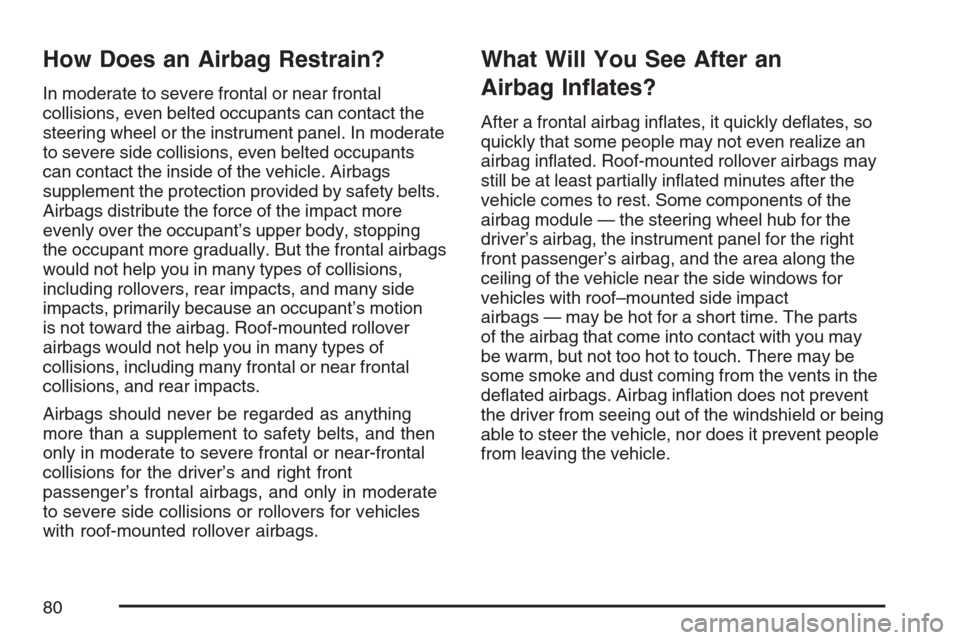
How Does an Airbag Restrain?
In moderate to severe frontal or near frontal
collisions, even belted occupants can contact the
steering wheel or the instrument panel. In moderate
to severe side collisions, even belted occupants
can contact the inside of the vehicle. Airbags
supplement the protection provided by safety belts.
Airbags distribute the force of the impact more
evenly over the occupant’s upper body, stopping
the occupant more gradually. But the frontal airbags
would not help you in many types of collisions,
including rollovers, rear impacts, and many side
impacts, primarily because an occupant’s motion
is not toward the airbag. Roof-mounted rollover
airbags would not help you in many types of
collisions, including many frontal or near frontal
collisions, and rear impacts.
Airbags should never be regarded as anything
more than a supplement to safety belts, and then
only in moderate to severe frontal or near-frontal
collisions for the driver’s and right front
passenger’s frontal airbags, and only in moderate
to severe side collisions or rollovers for vehicles
with roof-mounted rollover airbags.
What Will You See After an
Airbag In�ates?
After a frontal airbag in�ates, it quickly de�ates, so
quickly that some people may not even realize an
airbag in�ated. Roof-mounted rollover airbags may
still be at least partially in�ated minutes after the
vehicle comes to rest. Some components of the
airbag module — the steering wheel hub for the
driver’s airbag, the instrument panel for the right
front passenger’s airbag, and the area along the
ceiling of the vehicle near the side windows for
vehicles with roof–mounted side impact
airbags — may be hot for a short time. The parts
of the airbag that come into contact with you may
be warm, but not too hot to touch. There may be
some smoke and dust coming from the vents in the
de�ated airbags. Airbag in�ation does not prevent
the driver from seeing out of the windshield or being
able to steer the vehicle, nor does it prevent people
from leaving the vehicle.
80